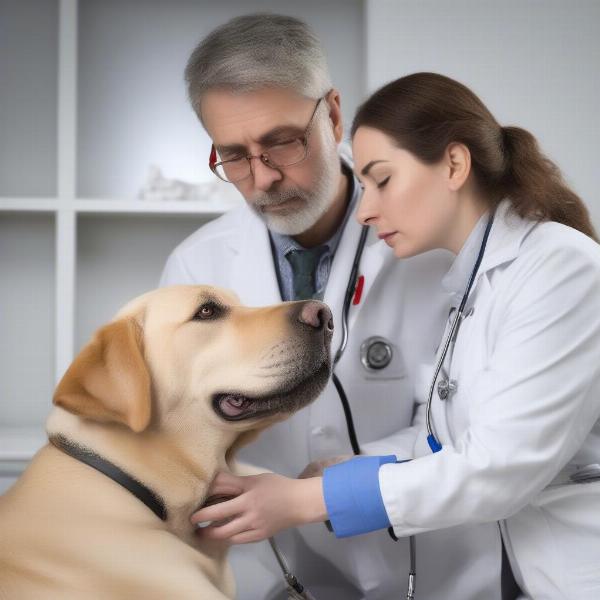If you’ve discovered your dog is eating plastic, you’re likely feeling worried. This is a common but serious problem that can have a range of consequences, from mild stomach upset to life-threatening blockages. Understanding why your dog eats plastic and knowing how to address this behavior is crucial for their health and well-being. This article will guide you through the causes, dangers, and solutions to this potentially dangerous habit.
Why Does My Dog Eat Plastic?
Several reasons can contribute to a dog’s unusual appetite for plastic. Puppies often explore their world through their mouths, and plastic’s texture and smell might be intriguing. Boredom or lack of stimulation can also lead to destructive chewing behaviors, with plastic becoming a target. Underlying medical conditions, such as pica (the craving for non-nutritive substances), can also contribute to this habit. Finally, some dogs simply enjoy the taste or texture of plastic, much like some humans chew on ice.
The Dangers of Eating Plastic
Plastic poses significant threats to a dog’s health. Small pieces of plastic can cause choking hazards, especially in puppies. Larger pieces or even plastic bags can obstruct the digestive tract, leading to vomiting, constipation, and potentially life-threatening blockages requiring surgery. Sharp plastic shards can cause internal injuries, including punctures and tears in the esophagus, stomach, or intestines. Furthermore, some plastics contain toxins that can leach into a dog’s system, posing long-term health risks.
What to Do If Your Dog Eats Plastic
If you catch your dog eating plastic, remove the item immediately. If you suspect your dog has swallowed a large piece or is exhibiting symptoms like vomiting, lethargy, loss of appetite, or straining to defecate, contact your veterinarian immediately. Early intervention is key to minimizing potential complications. Do not induce vomiting unless instructed by your veterinarian.
 Veterinarian examining a dog
Veterinarian examining a dog
Preventing Your Dog from Eating Plastic
Prevention is the best approach. Dog-proof your home by removing or securing any plastic items within your dog’s reach. Provide a stimulating environment with plenty of appropriate chew toys to redirect their chewing urges. Consider puzzle toys or food-dispensing toys to keep your dog engaged and mentally stimulated. Regular exercise and playtime can also help reduce boredom and anxiety, which can contribute to destructive behaviors. dog kennels heavy duty can also be useful in keeping your dog safe and contained when you can’t directly supervise them.
Training and Behavior Modification
Training can play a vital role in curbing this behavior. Teach your dog commands like “leave it” or “drop it” to prevent them from picking up plastic in the first place. Positive reinforcement, such as rewarding your dog for choosing appropriate chew toys, is more effective than punishment. If you’re struggling to manage this behavior, consult a certified dog trainer or behaviorist for personalized guidance.
Conclusion
Addressing a dog’s plastic-eating habit requires a multi-pronged approach involving prevention, training, and veterinary care when necessary. By understanding the underlying causes and taking proactive steps, you can protect your dog from the dangers of eating plastic and ensure their long-term health and well-being. Remember, a safe and stimulating environment combined with appropriate training can go a long way in preventing this dangerous behavior.
FAQ
-
What should I do if my dog swallowed a small piece of plastic? Monitor your dog closely for any changes in behavior or signs of distress. Contact your veterinarian if you notice anything unusual.
-
Can eating plastic kill a dog? Yes, depending on the size and type of plastic ingested, it can cause blockages or internal injuries that can be fatal.
-
What are some good alternatives to plastic chew toys? Natural rubber toys, rope toys, and toys made from durable, non-toxic materials are good alternatives.
-
How can I tell if my dog has pica? If your dog consistently eats non-food items, even when offered appropriate food and toys, consult your veterinarian to rule out any underlying medical conditions.
-
Is punishment effective in stopping a dog from eating plastic? Punishment is generally ineffective and can even worsen the behavior. Positive reinforcement and redirection are more effective training methods.
-
What kind of training should I do with my dog to stop them from eating plastic? Focus on commands like “leave it” and “drop it,” and reward your dog for choosing appropriate chew toys.
-
When should I seek professional help for my dog’s plastic-eating habit? If you’re struggling to manage the behavior on your own, or if your dog is exhibiting any signs of illness, consult a veterinarian or certified dog trainer.
ILM Dog is a leading online resource for dog owners worldwide, providing expert advice on all aspects of dog care and wellbeing. From breed selection to health and training, we offer comprehensive, practical information to help you navigate the joys and challenges of dog ownership. We specialize in providing guidance on dog breeds, health, training, nutrition, grooming, and accessories. If you are concerned about your dog eating plastic, please reach out for personalized support. Contact us at [email protected] or +44 20-3965-8624. ILM Dog is here to support you and your furry friend every step of the way.